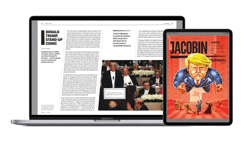To recap briefly, the shutdown was announced shortly after Time Inc ended its relationship with SID, moving the vast majority of its formerly SID-handled distribution (sales that accounted for 2% of Time Inc's total 2013 revenues, or about $70 million) to the largest wholesaler, TNG (formerly called The News Group). Time Inc filed a Securities and Exchange Commission (SEC) notification of that move on May 25, on the cusp of its early-June IPO / spinoff from parent Time Warner. The filing stated that Time Inc's "discontinued wholesaler" (later confirmed to be SID) had failed to make some $7 million in payments due from the first quarter, which Time Inc would have to write off as bad debt, along with another $19 million in uncollectible sales to SID made during Q2.
Time Inc stressed that its decision was made only after careful assessment of the "discontinued wholesaler's" financial condition and future business prospects, and discussions with that wholesaler. According to reports based on unnamed sources in Folio: and The New York Post, Time Inc had not been alone in deciding to cease supply to SID, although none of the parties cited in those reports confirmed such moves on the record.
In the SEC filing, Time Inc estimated that it would take about six to twelve weeks for TNG to fully ramp up to cover added retailers, during which period Time Inc would lose an estimated $4 million in sales, and incur about $1 million in transition costs.
As of the first week of June, based on a discussion with TNG US president David Parry, The New Single Copy's John Harrington ventured that it looked like "some level of supply" to the large retail locations / major retail chains that had been serviced by SID could be restored in under six to eight weeks.
Barnes & Noble and other bookstore chains that were serviced by SID are expected to be picked up not by TNG, but by direct distributor Ingram Periodicals. As of early June, it was unclear whether TNG's specialty division will opt to pick up the specialty retail accounts previously serviced by an SID division - meaning vertical retail outlets outside of supermarkets, mass merchants and drug chains that carry targeted selections of special-interest magazines.
In the wake of all this, all parties involved are obviously hoping that the disruption will be less prolonged and severe than when another major wholesaler, Anderson News, liquidated back in 2009 - in part because logistics and other lessons were learned from that previous disruption.
Impact on wholesaler economic model
Now, just two wholesalers control roughly 90% of the market. (The other, Hudson News, was the third-largest wholesaler prior to SID's demise.) One would think that this means that greater economies of scale will be possible for TNG.
But more important, in terms of hopes that the wholesaler economic model might be somewhat more sound going forward, is that, according to Harrington, in the second week of June, TNG sent out copies of new terms to national distributors and publishers. Those terms, he reported, require that, to be distributed by TNG going forward, publishers will need to indemnify TNG for any legal fees that might arise from any claims that might be brought by SID; that publishers who hadn't yet agreed to the per-copy distribution fees ranging from two to eight cents announced by TNG in late 2013 will now be required to do so; that publishers must agree to accept TNG's scan-based trading (SBT) procedures; that titles with annual frequencies of five times or fewer will be paid on a delayed basis to compensate for their extended on-sale times; and that for distribution in retail accounts newly acquired by TNG as of second-half 2014, publishers will agree to pay TNG "1.12% of total gross retail dollars distributed".
Also, in its SEC filing, Time Inc stated that changes to the payment terms in its revised agreement with its "selected wholesaler" [TNG] are "expected to result in an increase in days receivables outstanding and a resultant decrease in 2014 operating cash flows of approximately $12 million".
How will all of this pan out? That depends on a host of still-unanswered questions. Will publishers change their newsstand strategies significantly in response to the latest changes in newsstand economics? Can distributions, draws, cover pricing and consumer marketing practices be honed and enhanced in ways that offset additional costs or lower margins, and some additional lost unit sales not only in the short term, but in the longer term (due to some lost retail accounts formerly serviced by SID that may not be picked up by TNG or other distributors)? What effects will additional retail-channel pressures have on smaller publishers, in particular? What will happen to the specialty distribution channel that special interest publishers have become increasingly reliant on for single-copy sales? (Another specialty distributor, HDA, already went out of business earlier this year.)
As publishing consultant Linda Ruth pointed out, it's yet to be seen what it may mean for the industry now that just two wholesalers control most of the US's magazine distribution - wholesalers that also co-own one of the major NDs, Comag Marketing Group (CMG). (If you'll recall, TNG parent Jim Pattison Group acquired CMG from Hearst Magazines and Condé Nast in early 2012, and the Hudson Group soon after acquired a minority stake in CMG.)
In any case, we can only hope that the industry will absorb this latest jolt and resolve to redouble focus and investment in tackling the core problem of ongoing declines in unit single-copy sales. During the Retail Marketplace conference in June, Time Inc CEO Joe Ripp startled attendees (in a good way) by stating that the company has committed $50 million to promoting its magazines at retail next year. He also indicated that Time Inc is making practical strides in data exchanges with retailers. Other executives also stressed the importance of harnessing retail shopper marketing data, as well as advancing in-store mobile marketing capabilities.












